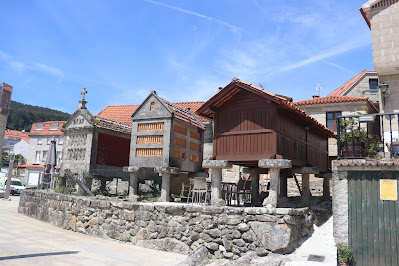 |
| Church of the Pilgrim Mary |
We left the ship at 8:30 AM to head into Spain with Rafiela,
our new guide. This part of Spain is called Galicia, and it has its own
language. The Romans settled here in the 1st century. Galicia also
included Northern Portugal until the 12th century when Portugal separated
from this part of Spain. Portuguese became a separate language over time. We
visited the town of Pontevedra
which lies along the Portuguese
Way to Santiago de Compostela. The Way is marked with seashells periodically
on the road. As we were leaving, we noticed the traffic lights weren’t working.
 |
| Seashell marking "The Way" |
We continued along the sea to the tiny village of Combarro. Here we stopped for lunch, but the restaurant had to create a new menu for us because a large region from Southern France, Spain, and Portugal were having a blackout. We had sausage with cheese, a Russian salad, and a tortilla, a cheese and potato omelet. The village itself consisted of two streets. Near each house were Horreos, small granaries. We saw several stone crosses, some with Mary on the other side. At the base is a small altar where the recent deceased may be displayed.
 |
| Horreros in Combarro |
We continued to Santiago de Costella. Here we learned how traffic continued to flow without traffic signals. Our hotel had a generator running for the public rooms, but no electricity in the rooms. We had planned on going to a grocery store for a simple dinner, but they were closed. We were happy we had some cash because no one could accept a credit card and the ATMs didn’t work. Lots of people were drinking and having a simple meal at the restaurants. We settled for our granola bars and some nuts we bought at a candy store. We read until dark then went to bed. Power was restored at about 3 AM, and the crisis was over.

No comments:
Post a Comment